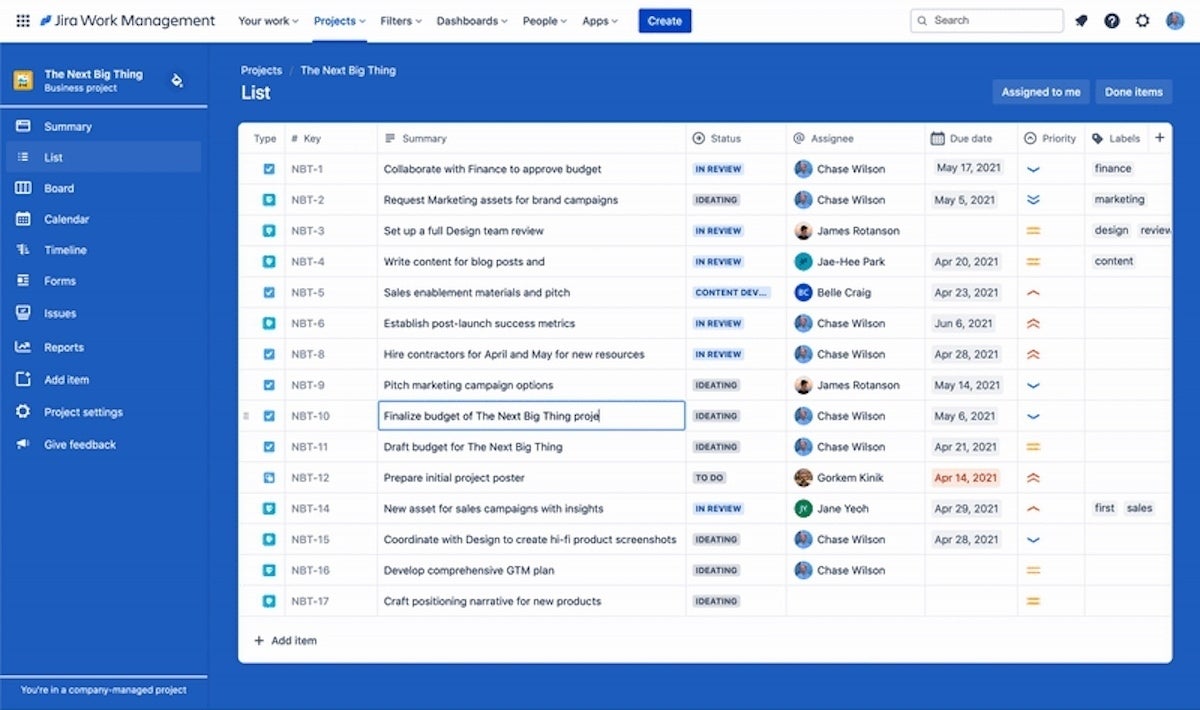Atlassian has launched a new platform, Jira Work Management, bringing Jira capabilities to all enterprise business teams and enabling departments like marketing, HR, finance, and design to easily connect their work with that of their technical counterparts.
Over the past year, organizations have had to compress multi-year digital transformation plans into weeks and months, with many scrambling to find the right tools to support their workers and allow collaborative work to continue.
Cameron Deatsch, chief revenue officer at Atlassian, said that although the company had seen a lot of organizations use platforms like Jira to track work while offices were closed, the company understands that sitting next to colleagues in the office offers benefits not easily replicated at home.
“There’s a whole bunch of stuff that’s easy to track when you’re ... with your team, but as you go virtual, you can’t just jump on a video call every time you want to have a conversation about a small task,” he said. “Obviously, you can do some of it over email, or Slack, or PowerPoint, or spreadsheets, but you aren’t able to keep track of things and it’s very easy to lose your work.”
Deatsch noticed that a growing number of companies with technical teams already using Jira were co-opting the platform for non-technical uses, squeezing and modifying it to deal with problems Jira wasn’t built to solve.
Charlez Betz, principal analyst serving infrastructure and operations professionals at Forrester Research, said the last 12 months has seen a shift in the project management arena.
“We see a clear move “from project to product” – long term, steady-state teams that continually handle a flow of ongoing improvement,” he said. “Jira at its core has long handled this reasonably well and Jira Work Management brings a similar capability forward for non-technical teams.”
For Deatsch, Jira Work Management represents a big step for Atlassian; taking the platform outside of what is considered its historical core of solving largely technical issues and turning it into something that supports broader work management processes.
While taking Jira out of the software development space might have initially raised eyebrows, the bigger risk for Atlassian was doing nothing, Betz said.
Core capabilities
Jira Work Management offers three core functionalities to help organizations achieve work continuity. These include an intuitive and easy to use platform, new view, and a connection to technical teams already using the traditional Jira platform.
The new views include:
- List, which extends the experience of a spreadsheet to Jira and provides an effective way to manage work at any scale, from individual workloads to large cross-company projects.
- Calendar, which adds the context of time to work, allowing companies to view deadlines and update work in an easy-to-comprehen” format.
- Timeline, which represents a fine-tuning of the traditional Gantt chart, designed to highlight connections and dependencies across workstreams.
- Board, which displays work tasks in the logical progression of the workflow it belongs to, giving users a flexible way of viewing, managing, and reporting on work in progress.
- And Forms, which offers drag-and-drop forms to collect requests and consolidate work related to projects, reducing friction and team disconnects.
The intuitive design takes into account that not every company looking to roll out Jira Work Management will have a “Jira Wizard” on site to walk new users through the platform. “We have a unique charter for work management, which is that new teams who jump onto [a platform] for the first time should be able to actually track and manage their work without any kind of training whatsoever,” said Chase Wilson, head of product marketing for Jira Work Management.
 Atlassian
Atlassian
Jira Work Management List view.
New users will have access to more than 20 new business project templates and get unlimited, free automation within projects. Users can select pre-made rules from the business automation library or create custom rules for any use case and department. Automation also connects with Slack, Microsoft Teams, and email providers to extend the power of Jira to other tools.
Additionally, while Jira Work Management takes into account that business teams work differently than their technical counterparts, the shared architecture between it, Jira Software, and Jira Service Management allows cross-department collaboration to happen seamlessly — even when the teams involved use different versions of the Jira platform.
 Atlassian
Atlassian
Jira Work Management Board view.
Betz said that, in general, Jira Work Management is consistent with the overall trend towards Enterprise Service Management.
“Jira as a framework is a powerful, stable, well known platform. It has not been quite as feature rich as major players such as ServiceNow and Cherwell (now Ivanti), but recent Atlassian acquisitions in the data management and UI spaces are closing the gap,” he said.






